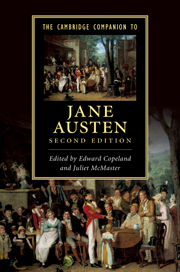Book contents
- Frontmatter
- 1 The Professional Woman Writer
- 2 Northanger Abbey And Sense And Sensibility
- 3 Pride And Prejudice And Mansfield Park
- 4 Emma And Persuasion
- 5 The Early Short Fiction
- 6 ‘Lady Susan’, ‘The Watsons’ And ‘Sanditon’
- 7 The letters
- 8 Class
- 9 Money
- 10 Making a living
- 11 Gender
- 12 Sociability
- 13 Jane Austen and literary traditions
- 14 Jane Austen on screen
- 15 Austen cults and cultures
- 16 Further reading
- Index
- Cambridge Companions to . . .
3 - Pride And Prejudice And Mansfield Park
Published online by Cambridge University Press: 28 March 2011
- Frontmatter
- 1 The Professional Woman Writer
- 2 Northanger Abbey And Sense And Sensibility
- 3 Pride And Prejudice And Mansfield Park
- 4 Emma And Persuasion
- 5 The Early Short Fiction
- 6 ‘Lady Susan’, ‘The Watsons’ And ‘Sanditon’
- 7 The letters
- 8 Class
- 9 Money
- 10 Making a living
- 11 Gender
- 12 Sociability
- 13 Jane Austen and literary traditions
- 14 Jane Austen on screen
- 15 Austen cults and cultures
- 16 Further reading
- Index
- Cambridge Companions to . . .
Summary
In Pride and Prejudice, Jane Austen draws on a battery of theatrical techniques to create her ‘light & bright & sparkling’ novel (L 203). In the more serious Mansfield Park, which she published next, theatricality itself becomes her subject. Elizabeth Bennet and Fanny Price could hardly be more different, but seeing that the action of Pride and Prejudice matches calendars for 1811–12, and Mansfield Park was ‘begun sometime about Feby 1811 – Finished soon after June 1813’, she was probably working on both manuscripts at once for a few months of 1811.1 It looks as if Austen built the first novel on dramatic devices, then went on to examine the whole enterprise of plays and play-acting in the second. In so doing, she brings to life a controversy as old as the stage itself.
Critics blame Evangelicalism for Austen’s apparent disapproval of drama in Mansfield Park, and yet the family put on plays, she enjoyed seeing plays performed, and she was extremely familiar with drama, players and theatre practices. Throughout her writing life, she turned plays into novels and delighted in reading her own scenes as well as other people’s out aloud. She may even have attended a performance of Lovers’ Vows, the play rehearsed at Mansfield Park. These contradictions may be resolved if Austen, rather than taking any definitive stance about the stage in Mansfield Park, threw herself into the long-running debate about dramatic embodiment.
- Type
- Chapter
- Information
- The Cambridge Companion to Jane Austen , pp. 39 - 54Publisher: Cambridge University PressPrint publication year: 2010
- 2
- Cited by



